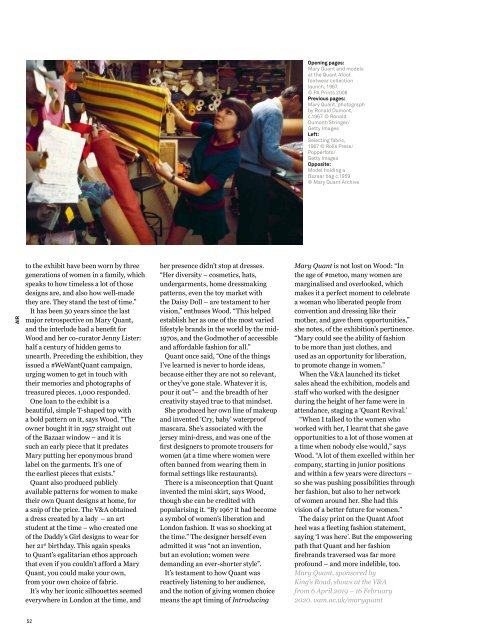You also want an ePaper? Increase the reach of your titles
YUMPU automatically turns print PDFs into web optimized ePapers that Google loves.
Opening pages:<br />
Mary Quant and models<br />
at the Quant Afoot<br />
footwear collection<br />
launch, 1967.<br />
© PA Prints 2008<br />
Previous pages:<br />
Mary Quant, photograph<br />
by Ronald Dumont,<br />
c.1967. © Ronald<br />
Dumont/Stringer/<br />
Getty Images<br />
Left:<br />
Selecting fabric,<br />
1967 © Rolls Press/<br />
Popperfoto/<br />
Getty Images<br />
Opposite:<br />
Model holding a<br />
Bazaar bag c.1959<br />
© Mary Quant Archive<br />
AIR<br />
to the exhibit have been worn by three<br />
generations of women in a family, which<br />
speaks to how timeless a lot of those<br />
designs are, and also how well-made<br />
they are. They stand the test of time.”<br />
It has been 50 years since the last<br />
major retrospective on Mary Quant,<br />
and the interlude had a benefit for<br />
Wood and her co-curator Jenny Lister:<br />
half a century of hidden gems to<br />
unearth. Preceding the exhibition, they<br />
issued a #WeWantQuant campaign,<br />
urging women to get in touch with<br />
their memories and photographs of<br />
treasured pieces. 1,000 responded.<br />
One loan to the exhibit is a<br />
beautiful, simple T-shaped top with<br />
a bold pattern on it, says Wood. “The<br />
owner bought it in 1957 straight out<br />
of the Bazaar window – and it is<br />
such an early piece that it predates<br />
Mary putting her eponymous brand<br />
label on the garments. It’s one of<br />
the earliest pieces that exists.”<br />
Quant also produced publicly<br />
available patterns for women to make<br />
their own Quant designs at home, for<br />
a snip of the price. The V&A obtained<br />
a dress created by a lady – an art<br />
student at the time – who created one<br />
of the Daddy’s Girl designs to wear for<br />
her 21 st birthday. This again speaks<br />
to Quant’s egalitarian ethos approach<br />
that even if you couldn’t afford a Mary<br />
Quant, you could make your own,<br />
from your own choice of fabric.<br />
It’s why her iconic silhouettes seemed<br />
everywhere in London at the time, and<br />
her presence didn’t stop at dresses.<br />
“Her diversity – cosmetics, hats,<br />
undergarments, home dressmaking<br />
patterns, even the toy market with<br />
the Daisy Doll – are testament to her<br />
vision,” enthuses Wood. “This helped<br />
establish her as one of the most varied<br />
lifestyle brands in the world by the mid-<br />
1970s, and the Godmother of accessible<br />
and affordable fashion for all.”<br />
Quant once said, “One of the things<br />
I’ve learned is never to horde ideas,<br />
because either they are not so relevant,<br />
or they’ve gone stale. Whatever it is,<br />
pour it out”– and the breadth of her<br />
creativity stayed true to that mindset.<br />
She produced her own line of makeup<br />
and invented ‘Cry, baby’ waterproof<br />
mascara. She’s associated with the<br />
jersey mini-dress, and was one of the<br />
first designers to promote trousers for<br />
women (at a time where women were<br />
often banned from wearing them in<br />
formal settings like restaurants).<br />
There is a misconception that Quant<br />
invented the mini skirt, says Wood,<br />
though she can be credited with<br />
popularising it. “By 1967 it had become<br />
a symbol of women’s liberation and<br />
London fashion. It was so shocking at<br />
the time.” The designer herself even<br />
admitted it was “not an invention,<br />
but an evolution; women were<br />
demanding an ever-shorter style”.<br />
It’s testament to how Quant was<br />
reactively listening to her audience,<br />
and the notion of giving women choice<br />
means the apt timing of Introducing<br />
Mary Quant is not lost on Wood: “In<br />
the age of #metoo, many women are<br />
marginalised and overlooked, which<br />
makes it a perfect moment to celebrate<br />
a woman who liberated people from<br />
convention and dressing like their<br />
mother, and gave them opportunities,”<br />
she notes, of the exhibition’s pertinence.<br />
“Mary could see the ability of fashion<br />
to be more than just clothes, and<br />
used as an opportunity for liberation,<br />
to promote change in women.”<br />
When the V&A launched its ticket<br />
sales ahead the exhibition, models and<br />
staff who worked with the designer<br />
during the height of her fame were in<br />
attendance, staging a ‘Quant Revival.’<br />
“When I talked to the women who<br />
worked with her, I learnt that she gave<br />
opportunities to a lot of those women at<br />
a time when nobody else would,” says<br />
Wood. “A lot of them excelled within her<br />
company, starting in junior positions<br />
and within a few years were directors –<br />
so she was pushing possibilities through<br />
her fashion, but also to her network<br />
of women around her. She had this<br />
vision of a better future for women.”<br />
The daisy print on the Quant Afoot<br />
heel was a fleeting fashion statement,<br />
saying ‘I was here’. But the empowering<br />
path that Quant and her fashion<br />
firebrands traversed was far more<br />
profound – and more indelible, too.<br />
Mary Quant, sponsored by<br />
King’s Road, shows at the V&A<br />
from 6 <strong>April</strong> <strong>2019</strong> – 16 February<br />
2020. vam.ac.uk/maryquant<br />
52

















